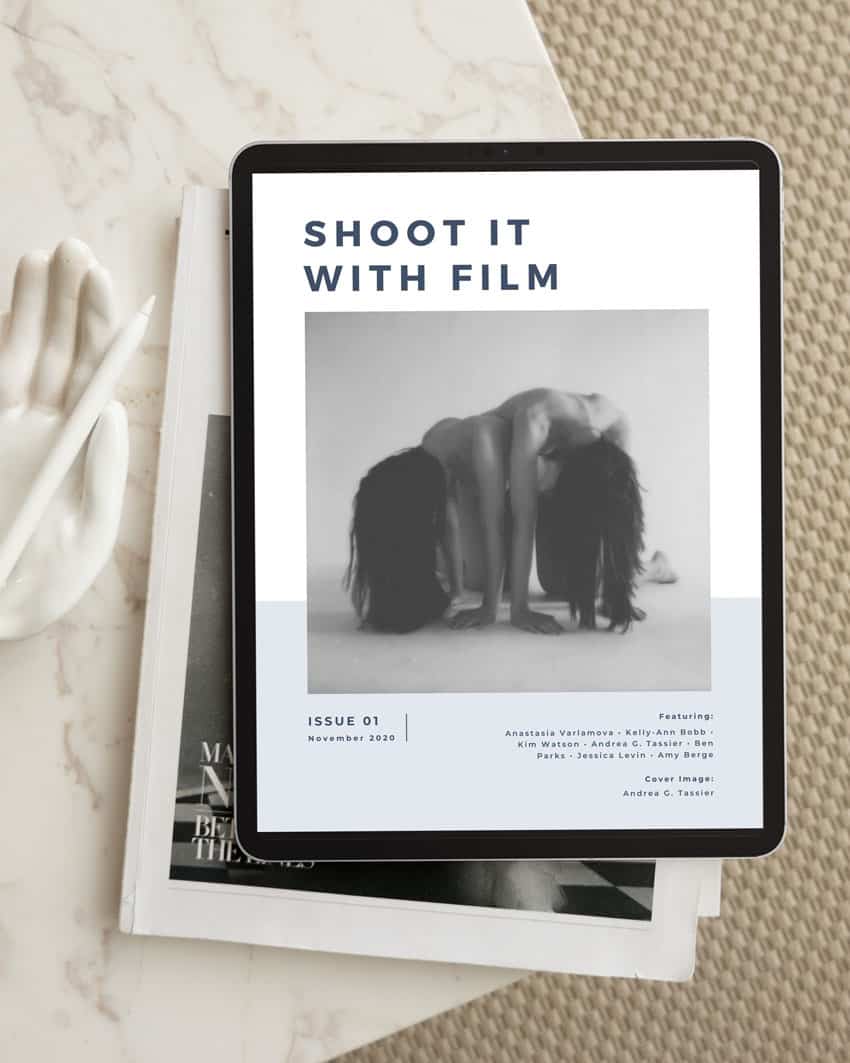
Written by Sara Johansen
Let me get this off my chest right from the start – I freaking love the Polaroid SX-70. I am so thoroughly in love with mine it hurts.
But, there’s a lot to consider when looking at a Polaroid SX-70 land camera, so I’m going to give you a quick lesson on how to use this camera along with an honest review to help you decide if it’s a camera you need in your arsenal.
Find the Polaroid SX-70 at KEH Camera or on eBay.

History of the Polaroid SX-70
Let’s start with a little history on the Polaroid SX-70 Land Camera.
The top secret project that Edwin Land, the creator of Polaroid, started was named SX-70, the SX standing for special experiment. Thus came the name of the camera, the SX-70 Land Camera, rightly named after Land himself.
If you’ve never read up on the history of Polaroid or how the SX-70 was developed, I suggest you check it out. This was the first ever instant film SLR camera, and this new technology changed the game.
It debuted in 1972 and quickly had a cult following that can still be found today (hi, I’m in the cult).



Polaroid SX-70 Basics:
A Foldable Design
The Polaroid SX-70 starts out as a compact, flat camera, making this camera a traveling dream.
To open, you need to pull up on the viewfinder, with, I might add, a bit of force. The first time I opened mine, I truly thought I was going to break it, but nope, it just needs a bit of muscle behind it.
First the viewfinder pops up, then keep pulling straight up until the entire camera pops open. Click the metal bar with an arrow into place to keep the camera open.
To close you will force this bar back down, and collapse the camera.


Focus Control
Once open, you’ll see the camera functions.
When looking at the front of the camera, the shutter release is the red button on the left. The all black wheel just about the shutter release is the focus wheel.
As mentioned above, it was the first instant film SLR camera, which is one of my favorite things about the SX-70. I love having control over my focal point and it really helps take images to the next level with this ability. To adjust, you simply dial the wheel to your desired focus.
Polaroid’s new I-2 camera may be the only other Polaroid with so much image control.

Exposure Adjustments
On the top right is a black and white wheel that will adjust the exposure of your image. By turning to the white, it adjusts for over exposure and by turning to the black, underexposure.
One thing I’ve found is that a little bit goes a long way, so usually if I do any adjusting it’s only by a half or full stop, measured by the line markers.
The exception to this is when I’m shooting backlit and I want any of my subjects to be fully lit. Then, I turn that sucker all the way to the white for over exposure. This usually compensates enough to essentially meter the shot for the shadows.



Light Meter and Flash
Just below the exposure control is the electric eye. There’s nothing you need to do with this when using the camera except to make sure your finger is not covering it.
This is where the camera reads the light to automatically determine the exposure needed.
Just above these features on the front is the flash socket.
While you still can find vintage flash bars to use (find on eBay), they’re a one and done and not very cost effective. Although the use of one is pretty fun. Luckily MiNT camera has developed a reusable flash bar that works great on the SX-70.
I used mine recently and was impressed with the great results. So if you need flash, that option is out there.

Loading Film
The bottom front part of the Polaroid SX-70 is where to load film and also where the film will eject when a picture is taken.
To load film, you’ll push the yellow button on the side and flip that bottom part open. Slide in your film pack, and push in.
Flip the door closed and the darkslide should pop out. If it does not, you either have an old pack of film where the battery no longer works or your camera is not working properly.
When taking a picture, be sure you’re not blocking where the film ejects, or your film will not eject smoothly and your film will develop with defects.



Remote Shutter, Viewfinder, and Image Counter
Also on the same side as the button to open the film door is a small two prong opening where you can connect a remote shutter button.
These are still available on eBay and work great for low light settings and also self portraits. MiNT also makes a self timer option that can be used in this connector.
When looking at the backside of the camera, you have your viewfinder up top and on the bottom left is the image counter.
Originally, packs of film were produced with 10 images, but they now only have 8. Since this is a vintage camera, it will always set at 10 and when you get to 2 on the counter, that is actually 0.



Things To Consider with the Polaroid SX-70:
ISO and Film Speed
The Polaroid SX-70 camera is a 160 speed ISO, so this camera needs a lot of light to perform well. The upside to this is that for those bright, sunny days, this is the Polaroid to have.
Obviously the downside is that indoor shooting can be tricky if in a spot that is not well lit.
Along with that, you need SX-70 film specifically in order to get the correct exposure on your images, as it’s currently the only Polaroid film made at 160 speed.
Polaroid 600 film is 600 speed, so while technically the SX-70 could spit out this film, your exposure will be off. There is a workaround to this in that SX-70 models can be modified to use 600 film. This is a nice option if you’re wanting round frames or other experimental film that Polaroid is producing.

Benefits of an SLR
One huge upside to the Polaroid SX-70, compared to other Polaroid cameras, is that there is no parallax correction needed. With it being a true SLR, what you see is what you get! What you see in the viewfinder is exactly what the lens sees.
This is really fantastic when you’re wanting that perfectly centered image. This is also super helpful if you’re trying to do experimental things with your images, like adding prisms or other accessories in front of the lens for creative effects like what Julia Beyer has shown us in this SIWF article.


The Sonar Model
There are several models of the Polaroid SX-70, as the camera and technology progressed through the years.
The biggest update was when the Sonar auto-focus feature was released. If you’re a lover of auto-focus, the sonar models are worth looking into.
The sonar feature takes a bit away from the sleek design of the camera, but the auto-focus can easily be switched on or off, making it quite versatile.

Film Inconsistencies
Another thing to consider when looking at getting an SX-70, or any Polaroid camera for that matter, is that the film can be fairly inconsistent.
It’s not the same chemistry as the original Polaroid film, as the Impossible Project had to start from scratch when reviving the discontinued film.
If the film is too cold or too hot, you’re going to get color shifts. The colors are also not always true to life. Personally I don’t mind this as I feel you really get a nostalgic and vintage feel to the images. But, if you’re not into that kind of look, you may not love the results.

Tips for Buying a Polaroid SX-70 Land Camera:
While the Polaroid SX-70 is no longer in production, you can still find them at KEH Camera or on eBay, or you can get a refurbished model. But I will warn you to be careful where and how you buy.
Here’s a couple of tips.
Only buy refurbished models from reputable sites and people. Just because it’s a big site selling, doesn’t mean it’s the best.
The first one I bought from a big site broke almost immediately due to it being refurbished with cheap parts. Luckily, I found someone to fix it, and, now, I buy solely from him, affectionately known as Dr. SX-70, or other people he knows that do solid work.
Brooklyn Film Camera is also a great spot to get quality refurbished SX-70s.


If you buy from a thrift shop or antique store, there’s a very good chance it will work! The best way to test is by getting a fresh pack of SX-70 film to try in it. Key word is fresh. If the pack is too old, the battery may not work, leading you to believe the camera doesn’t work, when in fact it’s the pack of film.
Also, if the price is right, even if not working, it may be worth buying and sending to Dr. SX-70 to get refurbished.
Test out your camera right away after receiving it so you can return if needed. There’s nothing worse than getting stuck with a faulty camera because you didn’t try it out right away.
Finally, do some research before purchasing. Take a look at the different models and also pay attention to pricing. The prices can vary wildly! It’s good to know the market a bit so you don’t overpay, but also be weary of low prices. If it seems too good to be true, it probably is.


Final Thoughts
As I said from the start, I freaking love this camera. But I think it’s incredibly important for those jumping into the Polaroid SX-70, or any Polaroid in general, to have realistic expectations of results.
It takes a little trial and error to find the sweet spot for your camera. And as I mentioned, sometimes the film is just not 100%.
But, there’s always magic in watching an image unfold in front of your eyes. To me, it’s worth it. I’ve even started incorporating Polaroids into my client work, which has been a big hit!
The Polaroid nostalgia is real, so if you’re wanting more of that, definitely look into the SX-70.
In my opinion, it’s the best Polaroid camera out there, AND it will always be a conversation piece whenever you pull one out. If you’re into aesthetics, the design of the SX-70 Land Camera truly cannot be beat. It’s the most beautiful camera out there, especially when it comes to instant cameras.
I would love to hear from you! Have you used an SX-70? Do you love it? What’s holding you back from trying one? Sound off in the comments!


Thank you so much, Sara! Sara is a regular contributor here at Shoot It With Film, and you can check out her other articles here, such as Five Tips for Shooting Film at Night and LomoChrome Turquoise Review.
You can also find more of Sara’s work on her website, Instagram, and print store.
Leave your questions about the Polaroid SX-70 below in the comments, and you can pick one up for yourself at KEH Camera or on eBay.








Blog Comments
Lynn MacAdam
September 23, 2023 at 7:50 pm
I couldn’t agree more, Sara! I freakin’ love this camera too! During Covid, and at a loss to do something creative that was ‘low contact’, I dug the SX-70 out from my husband’s small cache of vintage cameras, found I could order the film from Impossible Project, and took some of the best images I’ve ever taken. The B&W film, in particular, is amazing with this camera–I shot a lot of modern architecture and sculpture, which looks very vintage. Perfect! I’ve played around with polaroid lifts as well, which I learned to do here at Shoot it with Film. Thanks for this review!
Sara
September 25, 2023 at 8:40 am
Hi Lynn! So fun to hear your take on the SX-70! That’s truly amazing how it was such a fantastic camera for you during Covid. Thanks for reading and the comment!
Victor D. Reynolds
September 23, 2023 at 9:17 pm
I’m on my second SX-70 Sonar (the first was destroyed in an accident). I love this camera, especially on sunny days here in the Northeast. The color renditions are good if you shoot a well lit subject.
Sara
September 25, 2023 at 8:41 am
Hi Victor! You’re so right, the color renditions are very good in well-lit instances. It really is like a little bit of magic in each image. Thanks for reading and the comment!
Pavel
February 26, 2025 at 8:49 am
Hi Sara! Why do all your pictures seem blurry to me?
shootitwithfilm
March 2, 2025 at 9:17 pm
Hi Pavel! Polaroid images will always be a bit blurry. The lenses on instant cameras tend to be fairly simple with many of them being plastic, and instant film has a natural blurriness to it. 35mm or medium format would be a better fit if you’re looking for sharper images.